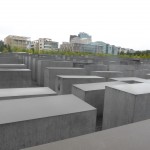Germany
Remembering Murder: Berlins Holocaust Memorial
How can you begin the represent the murder of 6 million people? How could one place possibly symbolise one of the most devastating moments in human history? The country that carries the weight of the most horrific genocide in history has gone to great efforts to illustrate the Halocaust, and the severe sufferings of the victims in the creation of Germans Holocaust Memorial in central Berlin.
Designed by American architect Peter Eisenmann, the Holocaust Memorial is one of the most evocative and controversial monuments to the Holocaust. Situated between Potsdamer Platz and the Brandenburg Gate, the Holocaust Memorial consumes a 4.7 acre site with 2,711 geometrically arranged concrete pillars. A centrepiece known as the “Field of Stelae”. It is fittingly located in the area which was once the home of Hitlers administrative centre, where the heinous acts of murder were devised.
 Although some critics protest the memorial, arguing that the abstract design does not present visitors with historical information about the Nazi campaign against the Jews, the tone of the memorial seems fitting.The Memorial can be seen as resembling a sea of nameless tombstones, in an attempt to captures the extreme horror of the Nazi concentration camps.
Although some critics protest the memorial, arguing that the abstract design does not present visitors with historical information about the Nazi campaign against the Jews, the tone of the memorial seems fitting.The Memorial can be seen as resembling a sea of nameless tombstones, in an attempt to captures the extreme horror of the Nazi concentration camps.
It is not possible to represent the Holocaust Memorial through photographs. Looking at images of the concrete jungle does not allow you to really appreciate the tone of the site. You must walk through the long, seemingly endless halls of nothing to experience the intentions of the site.
Although the memorial allows visitors to create their own interpretation, Mr. Eisenmann explains that “I don’t want people to weep and then walk away with a clear conscience.” After visiting the memorial, I know exactly what he means. The memorial isn’t a sad collection of traumatising images and realistic figures. It isn’t a collection of quotes and memories. It is chaos.
You walk past what seems like infinite blockades. You lose yourself in the sea of nothing. You will become confused, disoriented and yearning an explanation. While you are in the depths of the memorial you will lose control of your emotions. You know you are supposed to be sad, but it is all too overwhelming to feel anything. You are just another soul, lost in a sea of meaningless confusion. It is an illustration of evil.
Eventually you will leave. The pillows will gradually shrink as you emerge from the depths of the memorial. You may decide to get a coffee, or stop for a beer. You will smile as you get your photo talked in front of the Brandenburg Gate. You will laugh with your friends as you eat Currywurst. But when the conversation pauses and the laughter fades, you will remember the endless pillars. You will remember the confusion. You will remember murder.
Holocaust Memorial
Memorial to the Murdered Jews of Europe
Cora-Berliner-Straße 1
10117 Berlin
Phone: +49 (0) 30 – 26 39 43 36
Metro Stop: “Potsdamer Platz” (line U2, S1, S 2, S25)
Admission is free, but donations are appreciated.
The “Field of Stelae” is open at all times.
Opening Hours of the Information Center:
April – September: 10 a.m. to 8 p.m. (last entrance 7.15 p.m.)
October – March 10 a.m. to 7 p.m. (last entrance 6.15 p.m.).
closed on Mondays, except public holidays.
Guided Tours:
Guided Tours (1.5 hours) provide general information on the history and design of the Memorial and the Information Center; no reservation required
Saturday and Sunday 11:00 a.m.; 2:00 p.m. (in German)
Sunday 4:00 p.m. (in English)
Cost: 3 Euros
Audio Guides
The Audio Tour (1 hour) offers an overview of the historical background of the Holocaust in Europe, including testimonies of witnesses and historians.
Cost: 3 Euros











